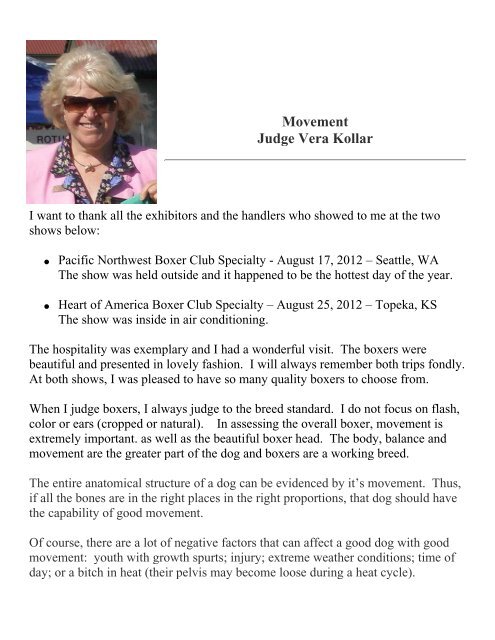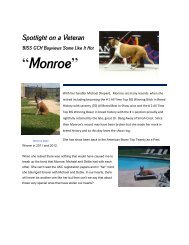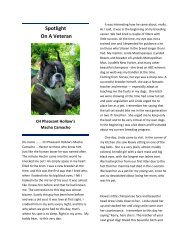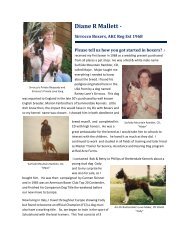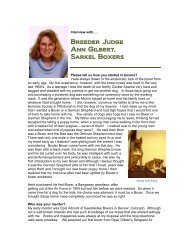Movement Judge Vera Kollar - Boxer Daily
Movement Judge Vera Kollar - Boxer Daily
Movement Judge Vera Kollar - Boxer Daily
Create successful ePaper yourself
Turn your PDF publications into a flip-book with our unique Google optimized e-Paper software.
<strong>Movement</strong><br />
<strong>Judge</strong> <strong>Vera</strong> <strong>Kollar</strong><br />
I want to thank all the exhibitors and the handlers who showed to me at the two<br />
shows below:<br />
� Pacific Northwest <strong>Boxer</strong> Club Specialty - August 17, 2012 – Seattle, WA<br />
The show was held outside and it happened to be the hottest day of the year.<br />
� Heart of America <strong>Boxer</strong> Club Specialty – August 25, 2012 – Topeka, KS<br />
The show was inside in air conditioning.<br />
The hospitality was exemplary and I had a wonderful visit. The boxers were<br />
beautiful and presented in lovely fashion. I will always remember both trips fondly.<br />
At both shows, I was pleased to have so many quality boxers to choose from.<br />
When I judge boxers, I always judge to the breed standard. I do not focus on flash,<br />
color or ears (cropped or natural). In assessing the overall boxer, movement is<br />
extremely important. as well as the beautiful boxer head. The body, balance and<br />
movement are the greater part of the dog and boxers are a working breed.<br />
The entire anatomical structure of a dog can be evidenced by it’s movement. Thus,<br />
if all the bones are in the right places in the right proportions, that dog should have<br />
the capability of good movement.<br />
Of course, there are a lot of negative factors that can affect a good dog with good<br />
movement: youth with growth spurts; injury; extreme weather conditions; time of<br />
day; or a bitch in heat (their pelvis may become loose during a heat cycle).
I believe would like to take this opportunity to explain movement as it was taught to<br />
me. I will address the boxer gait as it is stated in the <strong>Boxer</strong> Breed Standard below.<br />
Gait<br />
Viewed from the side, proper front and rear angulation is manifested in a smoothly<br />
efficient, level-backed, ground covering stride with a powerful drive emanating<br />
from a freely operating rear.<br />
I believe the key word here is efficient. A properly moving dog runs<br />
with less exertion of energy and can run longer and cover more<br />
ground. This is why movement judges will run your dogs more. The<br />
dogs that are not running efficiently and cannot cover ground with<br />
the others in the ring will burst into a gallop or tire very quickly.<br />
A freely operating rear drives the front of the dog efficiently and does<br />
not mean they are kicking their legs high into the air as they run. Try<br />
simulating that yourself as you run. It is not efficient.<br />
Although the front legs do not contribute impelling power, adequate reach should<br />
be evident to prevent interference, overlap, or sidewinding (crabbing).<br />
This can be clearly seen from the side when a dog is moving. A<br />
correctly moving dog will have the front and hind legs come together<br />
touching tips of their toes. If the hind legs are coming under the<br />
body and overlapping the front legs as it also comes under the body,<br />
the dog is sidewinding in order to prevent the back feet from stepping<br />
on their front feet. Incorrect movement will be evidenced with<br />
sidewinding, running wide in the front or wide in the rear to avoid<br />
stepping on their feet.<br />
If a dog is running high in the rear, it can be because the hind legs<br />
are too long for the front legs and they cannot produce proper foot<br />
placement.<br />
Viewed from the front, the shoulders should remain trim and the elbows not flare<br />
out.
A dog who is running with their elbows flared out will typically cross<br />
over in the front or have one or both feet curve inward with foot<br />
placement.<br />
The legs are parallel until gaiting narrows the track in proportion to increasing<br />
speed, then the legs come in under the body but should never cross.<br />
It is obvious to see legs that cross in the front. If a dog is running<br />
wide in the rear, they will look like they are kicking their feet out to<br />
the sides when coming in to you on a down and back.<br />
The line from the shoulder down through the leg should remain straight<br />
although not necessarily perpendicular to the ground.<br />
This imaginary line extends from the shoulder through the leg as they<br />
reach. This reach is determined by a correct shoulder assembly. The<br />
two shoulder blades on top of the dog’s shoulders should be quite<br />
close together and 2-3 fingers apart between the top of the shoulder<br />
blades.<br />
If the shoulder blades are farther apart is makes a straighter line (up<br />
and down) with the bottom of the shoulder where it connects to the<br />
leg (straight shoulders). This limits the range of the lower leg and the<br />
leg will appear to have a right angle to the body when running rather<br />
than a straight line.<br />
For example, stretch your arm out in front of you and the straighter<br />
the shoulder (wider shoulder blades), the more your elbow will be<br />
pulled in towards your waist.<br />
(Examples)<br />
Viewed from the rear, a <strong>Boxer</strong>'s rump should not roll.
The dog’s reach occurs from the front and the drive occurs from the<br />
back. The ribcage stabilizes the drive to push the dog forward which<br />
is why the standard includes:<br />
The ribs, extending far to the rear, are well-arched but not barrel-shaped (ref. Body<br />
section).<br />
If the ribcage is shorter, there is less to stabilize the rear drive and<br />
you will see a rolling rump as each leg’s drive pushes and twists the<br />
rump left or right.<br />
The hind feet should dig in and track relatively true with the front. Again, as<br />
speed increases, the normally broad rear track will become narrower.<br />
The easiest way to tell if a dog’s hind feet are digging in with drive is<br />
to check the thighs. Dogs that dig in will have strong thigh muscles.<br />
Dogs with very little thigh muscles are not compelling drive from the<br />
rear. They have a front wheel drive chassis.<br />
If you think that a dog moving with a wide rear track or one that is<br />
double tracking in the rear (legs that step wide and then narrow and<br />
then wide again) is efficient, I suggest you run on a down and back<br />
and a go around mimicking their movement. It is not easy, nor is it<br />
efficient.<br />
If the hind feet are moving relatively true with the front, that means<br />
that the front and rear feet on each side of the dog are running in the<br />
same path.<br />
To see your dog’s foot paths, run them in snow or dip their feet in<br />
water and run them on a sidewalk. Their footprints will show their<br />
movement.<br />
The <strong>Boxer</strong>'s gait should always appear smooth and powerful, never stilted or<br />
inefficient.


